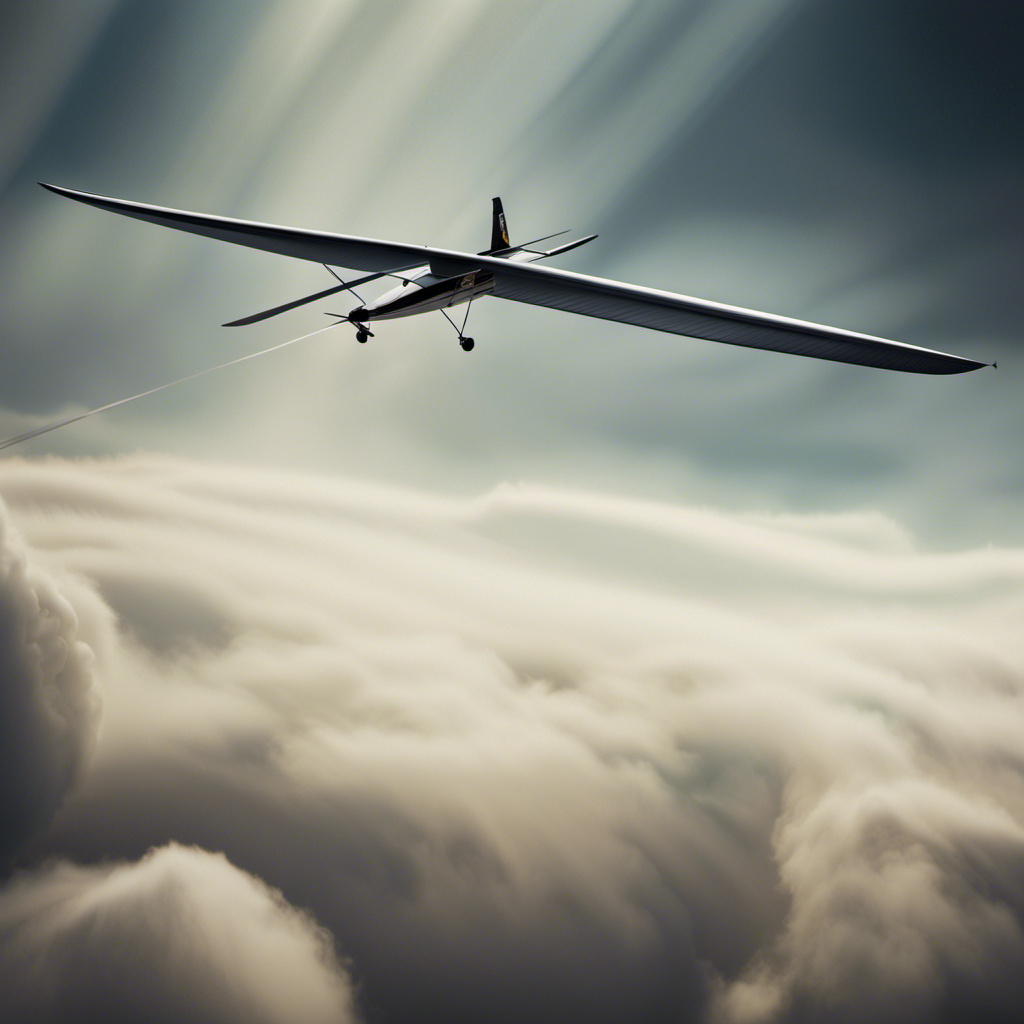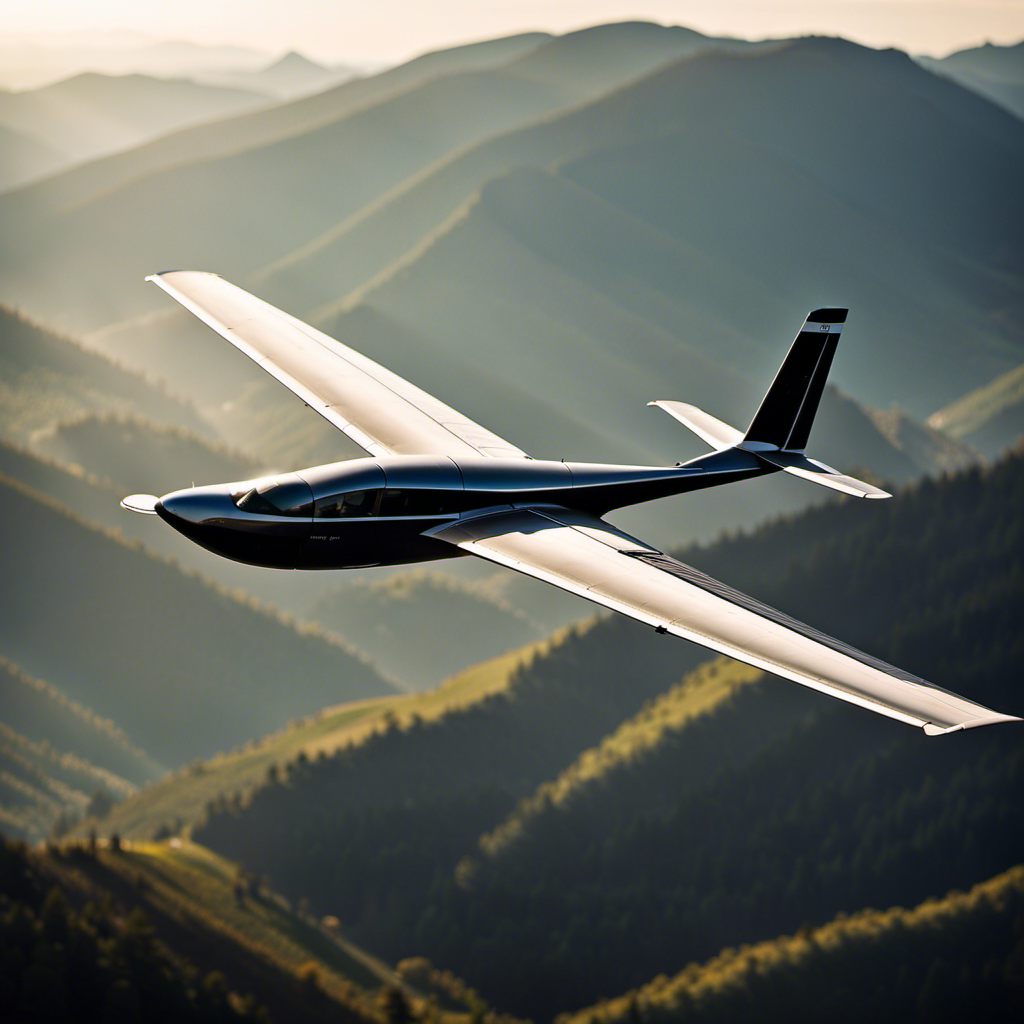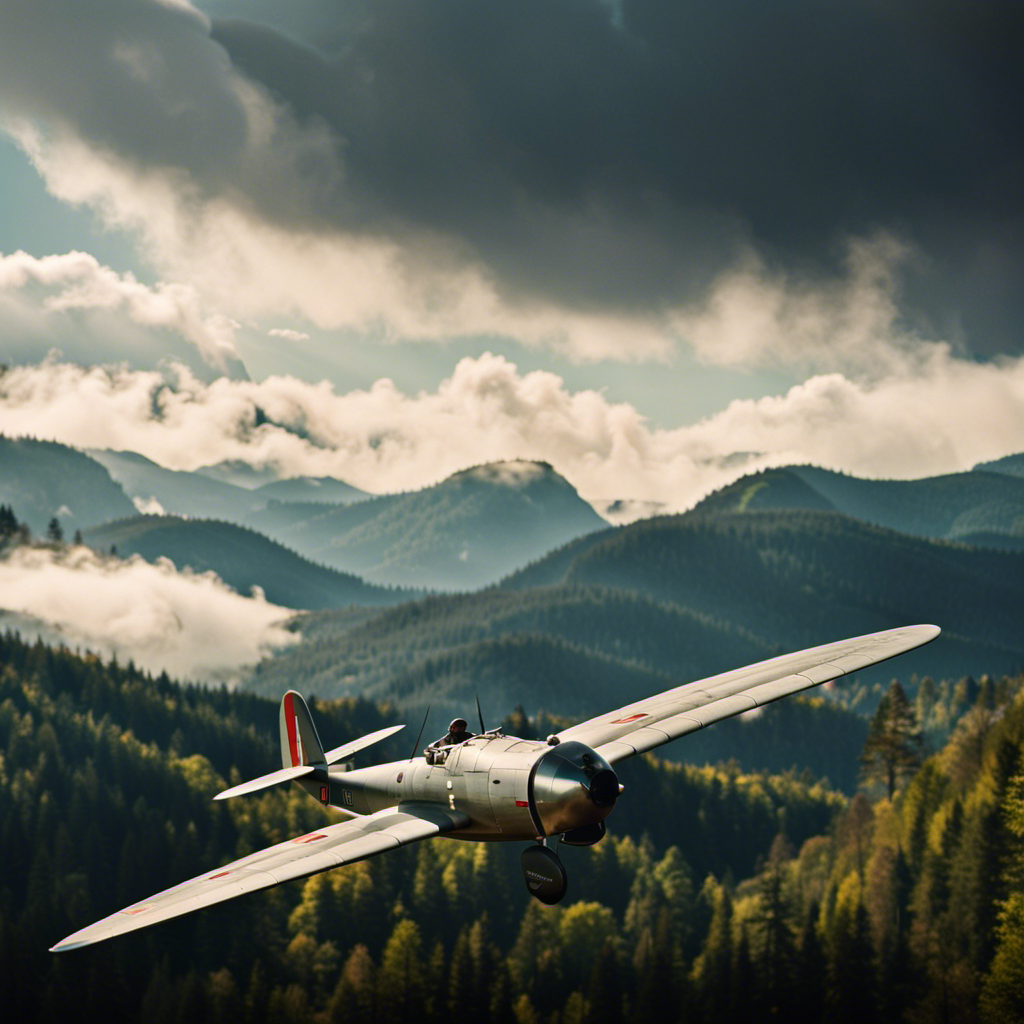As a glider pilot, I have been asked by many if gliders can soar in windy conditions. To all those who are curious, let me state unequivocally: yes, they can.
Gliders not only have the ability to soar through calm skies, but they are also designed to take advantage of windy conditions.
In this article, we will delve into the science behind gliding, explore how gliders stay airborne in windy conditions, discuss the benefits and techniques of flying in wind, and shed light on the future of glider technology.
So, buckle up and prepare to be amazed by the exhilarating world of glider flying in wind!
Key Takeaways
- Gliders rely on aerodynamics to generate lift and can stay airborne by manipulating the shape and design of their wings.
- Gliders can harness wind currents, such as those near wind turbines, thermals, and ridges, to generate lift and gain altitude.
- Observing and analyzing wind patterns is crucial for adjusting flight techniques, including flying close to ridges or hills to utilize ridge lift or slope soaring.
- Flying gliders in windy conditions extends flight times, provides increased maneuverability, and allows for challenging and dynamic flying experiences.
The Science Behind Gliding
You’re probably wondering how gliders are able to stay in the air without an engine. Well, it all comes down to the science of gliding and the principles of aerodynamics.
Gliders are designed to take advantage of wind currents to generate lift and sustain flight. By carefully manipulating the shape and design of the wings, gliders are able to create an upward force that counteracts gravity. This is achieved through a combination of factors such as the wing’s camber, angle of attack, and airfoil shape.
The wings are expertly designed to generate lift as air flows over and under them. As a result, the glider can stay airborne for extended periods, relying solely on the power of the wind.
Now, let’s explore how gliders stay in the air even in windy conditions.
How Gliders Stay Airborne in Windy Conditions
As a glider pilot, I’ve learned to utilize wind as a crucial source of lift during flight. By understanding the aerodynamics of gliding, I can effectively use wind to my advantage.
In addition to utilizing wind, I also take advantage of thermals and ridge lift. These natural phenomena provide additional lift and prolong my flight time.
To optimize my flights in different wind conditions, I adjust my flight techniques. This includes adjusting my speed and angle of attack to optimize lift and control during windy flights.
Using Wind as a Source of Lift
Though it may seem counterintuitive, gliders can actually harness the power of wind to generate lift. By utilizing the principles of glider aerodynamics, gliders can take advantage of wind currents to stay airborne.
One way gliders use wind as a source of lift is by flying near wind turbines. As the wind passes through the turbine blades, it creates an updraft of air that the glider can ride on, effectively generating lift. This technique allows gliders to stay aloft for longer periods, conserving energy and extending their flight time.
Another way gliders utilize wind is by flying in areas with strong updrafts, such as near thermals or along ridges. These natural wind currents provide the necessary lift for gliders to maintain altitude and even gain altitude without the need for an engine.
Taking Advantage of Thermals and Ridge Lift
By harnessing thermals and ridge lift, gliders can effortlessly gain altitude and prolong their flight time.
Thermals are columns of warm air that rise due to heating from the sun. Gliders can detect thermals by sensing changes in temperature and air pressure. When flying through a thermal, the glider’s wings generate lift, allowing it to climb higher.
Ridge lift, on the other hand, is created when wind encounters a mountain or ridge. As the wind hits the obstacle, it is forced to rise, creating an upward flow of air. Gliders can ride this upward flow, gaining altitude without the need for an engine.
Maximizing wind lift requires careful observation of wind patterns, as well as skillful positioning and maneuvering of the glider. By understanding the dynamics of thermals and ridge lift, glider pilots can make the most of these natural phenomena to stay airborne and cover greater distances.
Transitioning into adjusting flight techniques in different wind conditions, pilots must adapt their strategies to maximize lift and maintain control.
Adjusting Flight Techniques in Different Wind Conditions
To adjust your flight techniques in different wind conditions, you need to carefully observe and analyze the patterns of the air currents. Understanding wind patterns is crucial for safe and efficient glider flying.
When faced with strong winds, it is essential to adjust your flight techniques accordingly. One important technique is to use the wind to your advantage by utilizing ridge lift or slope soaring. By flying close to a ridge or hill, you can take advantage of the upward lift created by the wind as it flows over the terrain. This allows you to maintain altitude and even gain height without expending much energy.
Another technique is to adjust your speed and heading to compensate for the wind direction and intensity. By flying at the appropriate speed and angle, you can maintain control and stability in windy conditions.
These adjustments in flight techniques are crucial for a successful glider flight in varying wind conditions.
Transitioning to the subsequent section about the benefits of flying gliders in windy conditions, it is important to note that despite the challenges, flying in windy conditions can offer unique advantages for glider pilots.
The Benefits of Flying Gliders in Windy Conditions
When it comes to flying gliders in windy conditions, there are several benefits to consider.
Firstly, extended flight times can be achieved due to the increased lift generated by the strong winds. This allows gliders to stay airborne for longer periods, maximizing their potential for exploration and enjoyment.
Additionally, the windy conditions provide increased maneuverability, allowing pilots to perform more advanced and dynamic maneuvers, providing an exhilarating and challenging flying experience.
Extended Flight Times
You can achieve longer flight times by adjusting the glider’s wing shape and weight distribution.
Extending flight endurance is crucial for glider pilots who aim to stay aloft for extended periods. By optimizing glider design, we can maximize the efficiency of the aircraft and increase its ability to stay airborne.
One approach is to modify the wing shape to reduce drag and increase lift. This can be done by incorporating various wingtip designs, such as winglets or upturned wingtips.
Additionally, redistributing the weight of the glider can improve its overall performance. By shifting the center of gravity, we can enhance stability and control, allowing the glider to remain in the air for longer periods.
These adjustments not only extend flight times but also pave the way for increased maneuverability in the next section.
Increased Maneuverability
For improved maneuverability, try adjusting the wing shape and weight distribution of your glider. By making these adjustments, you can achieve increased control over your glider’s movements, allowing you to perform advanced techniques with ease.
Here are some techniques that can enhance your flying experience:
-
Camber adjustment: By changing the curvature of the wing, you can optimize lift and reduce drag, improving the glider’s responsiveness.
-
Center of gravity manipulation: Shifting the weight distribution can affect the glider’s stability and control. Experiment with different positions to find the optimal balance.
-
Flap deployment: Utilizing flaps can increase lift and maneuverability during takeoff and landing, enabling tighter turns and more precise flying.
Implementing these techniques will give you a challenging and exciting flying experience, pushing the limits of what your glider can achieve.
Transitioning seamlessly into the subsequent section, you’ll discover the thrill of soaring through the sky.
Challenging and Exciting Flying Experience
After exploring the increased maneuverability of gliders, let’s dive into the exhilarating world of flying gliders in challenging conditions.
As a glider pilot, I have had the privilege of experiencing thrilling flights in various weather conditions. Flying in challenging conditions, such as strong winds, adds an extra layer of excitement and complexity to the flying experience.
The wind creates dynamic and unpredictable air currents that require a pilot’s utmost skill and concentration. It demands precise control inputs to maintain stability and ensure a safe flight. Despite the demanding nature of flying in windy conditions, it offers an unparalleled sense of accomplishment and mastery.
Now, let’s explore the techniques for flying in windy conditions without compromising safety or control.
Techniques for Flying in Windy Conditions
To effectively fly in windy conditions, it’s important to utilize techniques that increase stability and control. Here are three key techniques for adjusting flight techniques in windy conditions:
-
Weight Shift: By shifting your body weight in the opposite direction of the wind, you can counterbalance the forces and maintain better control over the glider.
-
Speed Adjustment: Adjust your flying speed to match the wind conditions. Flying faster can help you maintain stability and maneuverability, while flying slower can reduce the risk of turbulence.
-
Wing Flaps: Utilize the wing flaps to increase lift and stability. By adjusting the angle of the flaps, you can optimize the glider’s performance in windy conditions.
Safety Considerations for Flying Gliders in Windy Conditions
When flying gliders in windy conditions, it is crucial to prioritize safety and take appropriate precautions. As a glider pilot, I understand the importance of adjusting flight techniques to ensure a smooth and controlled flight.
One key consideration is maintaining a proper airspeed to counteract the effects of the wind. This involves closely monitoring the glider’s speed and making necessary adjustments to prevent stalling or loss of control.
Additionally, it is essential to be mindful of wind direction and its potential impact on thermals, ridge lift, and turbulence. By staying vigilant and aware of these factors, pilots can mitigate risks and enhance their safety during windy flights.
Now, let’s explore some valuable tips for glider pilots to improve their skills in windy weather flying.
Tips for Glider Pilots to Improve Windy Weather Flying Skills
One valuable tip for glider pilots looking to enhance their skills in windy weather flying is to closely monitor airspeed. This is crucial because flying in windy conditions requires precise control and adjustments to maintain stability and safety.
To improve your skills in windy weather flying, consider the following:
-
Study wind patterns: Understanding how wind behaves in different conditions will help you anticipate changes and make informed decisions during flight.
-
Be aware of wind shear effects: Wind shear is the sudden change in wind speed or direction, which can affect the handling and stability of your glider. Stay vigilant and be prepared to adjust your flight path accordingly.
-
Practice crosswind landings: Mastering the technique of landing in crosswinds will greatly improve your overall flying skills in windy conditions.
-
Seek guidance from experienced pilots: Learning from the experiences and knowledge of seasoned glider pilots can provide invaluable insights and help you become a more confident flyer.
By following these tips and continuously honing your skills, you will become a more adept glider pilot in windy weather conditions.
Now, let’s address some common myths and misconceptions about gliders and wind.
Common Myths and Misconceptions About Gliders and Wind
As a glider pilot, I have often heard concerns about gliders being blown away by strong winds, being unstable in windy conditions, and being limited to calm weather. However, it is important to dispel these myths and misconceptions.
While it is true that gliders can be affected by strong winds, proper training and techniques can help mitigate the risks and ensure safe flying. Additionally, advancements in glider design and technology have made them more stable and capable of flying in a wider range of weather conditions.
Therefore, it is crucial to have a comprehensive understanding of glider capabilities and limitations to make informed decisions when it comes to flying in windy conditions.
Gliders Being Blown Away by Strong Winds
If you’re flying a glider in strong winds, you might get blown away. Glider safety precautions must be taken to ensure a safe flight in windy conditions. Here are three key considerations when it comes to wind patterns and glider flight:
-
Wind direction: Before taking off, it is crucial to assess the wind direction. Glider pilots should always take off and land into the wind to maximize control and minimize the risk of being blown off course.
-
Wind speed: Strong winds can pose a significant challenge for glider pilots. It is important to monitor wind speed and avoid flying in conditions where gusts may exceed the glider’s capabilities.
-
Wind shear: Wind shear refers to a sudden change in wind speed or direction over a short distance. Pilots must be aware of potential wind shear conditions, as they can cause sudden and unpredictable changes in glider performance.
Considering these factors, it is evident that gliders are susceptible to being blown away in strong winds. However, this is just one aspect of the challenges they face in windy conditions.
Gliders Being Unstable in Windy Conditions
Flying a glider in windy conditions can be challenging due to their instability. Gliders are designed to be lightweight and have a high glide ratio, which makes them highly susceptible to the effects of wind.
The stability of a glider is determined by factors such as wing design, weight distribution, and control surfaces. When the wind blows, it creates turbulence and gusts that can cause the glider to become unstable. The wind can affect the glider’s performance by causing it to pitch, roll, or yaw unexpectedly.
This can make it difficult for the pilot to maintain control and can even lead to dangerous situations. Therefore, gliders are generally limited to flying in calm weather conditions where the wind effects are minimal.
Gliders Being Limited to Calm Weather
In the previous section, we explored the challenges of flying gliders in windy conditions, which can lead to instability and potential dangers. However, gliders are not limited to flying only in calm weather. By harnessing the power of wind currents, glider performance can be greatly enhanced, allowing for longer flights and more adventurous maneuvers.
One key factor in utilizing wind currents is understanding how they behave in different weather conditions. By studying meteorological data and charts, glider pilots can identify areas of strong updrafts, known as thermals, which can provide the necessary lift to keep the glider airborne for extended periods of time. Additionally, ridge soaring and wave flying techniques can be employed to take advantage of wind patterns created by the terrain and atmospheric conditions.
To illustrate the impact of wind currents on glider performance, consider the following table:
| Wind Speed (knots) | Glider Performance |
|---|---|
| 0-5 | Limited climb rate |
| 5-10 | Moderate climb rate |
| 10-15 | High climb rate |
| 15+ | Extreme climb rate |
As we can see, the higher the wind speed, the greater the potential for glider performance. By understanding and utilizing wind currents effectively, glider pilots can explore new heights and distances, pushing the boundaries of their flying experience.
Transitioning into the subsequent section, we will now delve into the role of weather forecasting in glider flying, which is crucial for planning safe and successful flights.
The Role of Weather Forecasting in Glider Flying
You should pay attention to weather forecasts because they play a crucial role in glider flying. Weather forecasting provides valuable information about wind patterns, air pressure systems, and other atmospheric conditions that directly impact glider performance.
By analyzing weather forecasts, glider pilots can determine if the weather conditions are suitable for flying, ensuring the safety and efficiency of their flights. Understanding wind direction and speed is particularly important for glider pilots, as they rely on thermals and ridge lift to stay aloft.
Weather forecasts help glider pilots identify areas with favorable wind conditions, allowing them to plan their flights to maximize performance. By utilizing weather forecasting, glider pilots can make informed decisions about when and where to fly, optimizing their gliding experience.
Transitioning to famous glider flying destinations for windy conditions, let’s explore some renowned locations that attract glider enthusiasts worldwide.
Famous Glider Flying Destinations for Windy Conditions
One of the most well-known destinations for glider enthusiasts seeking windy conditions is the Sierra Nevada mountain range in California. This region offers several advantages for glider flying.
Firstly, the Sierra Nevada has strong thermal activity. The warm air rising from the valleys and slopes creates powerful thermals that gliders can use to gain altitude and stay aloft for extended periods.
Secondly, there are ridge soaring opportunities. The mountain range’s steep slopes and strong winds provide ideal conditions for ridge soaring. Gliders can fly close to the ridges and use the wind to stay airborne.
Thirdly, the Sierra Nevada has dynamic weather patterns. The unpredictable weather, including gusty winds and turbulence, offers a thrilling and challenging experience for glider pilots.
Lastly, flying over the Sierra Nevada offers stunning scenery. Glider enthusiasts can enjoy breathtaking views of snow-capped peaks, deep valleys, and picturesque landscapes.
With the ideal conditions offered by the Sierra Nevada, it’s no wonder that it has become a famous destination for glider flying.
Transitioning into the subsequent section, gliding competitions and records have been set in these windy conditions, showcasing the skill and expertise of glider pilots.
Gliding Competitions and Records in Windy Conditions
As a glider pilot myself, I’ve always been fascinated by the world of gliding competitions and the remarkable records that have been set.
The World Gliding Championships, held every two years, gather the most skilled pilots from around the globe to compete in various disciplines, showcasing their expertise in soaring flight.
These competitions not only test pilots’ abilities to navigate long-distance cross-country flights, but also push the boundaries of speed and altitude, resulting in awe-inspiring records.
These records continue to inspire the gliding community, as pilots strive to achieve new heights and push the limits of what is possible in gliding.
World Gliding Championships
The World Gliding Championships are showcasing the impressive skills of gliders in wind conditions. As a glider pilot myself, I have been fortunate enough to participate in these prestigious competitions and witness firsthand the remarkable techniques employed by pilots to navigate through challenging wind patterns.
Here are some key techniques utilized by glider pilots in the World Gliding Championships:
-
Dynamic soaring: Pilots exploit the energy in the wind by flying in a circular path, gaining speed as they descend and then climbing back up using the wind’s energy.
-
Ridge soaring: By flying close to mountain ridges, pilots take advantage of the updrafts created by the wind hitting the slope, allowing them to gain altitude and sustain flight.
-
Thermal soaring: Glider pilots search for thermals, which are columns of warm rising air, and use them to gain altitude by circling within these rising air currents.
These techniques, perfected by skilled glider pilots, enable them to navigate the challenging wind conditions encountered in the World Gliding Championships.
Transitioning to the subsequent section about ‘long-distance cross-country flights,’ glider pilots also employ these techniques to cover vast distances, relying on wind currents to carry them across the sky.
Long-distance Cross-Country Flights
To cover vast distances during long-distance cross-country flights, you’ll rely on the same techniques that skilled glider pilots use in the World Gliding Championships.
These flights require extended flight times and increased maneuverability, both of which are essential for navigating varying wind conditions and maximizing efficiency. By utilizing thermals, ridge lift, and wave lift, glider pilots can extend their flight times and cover hundreds of miles without the need for an engine.
They carefully analyze weather patterns and use their knowledge of aerodynamics to make precise adjustments, optimizing their glide ratio and minimizing drag. This allows them to stay aloft for hours, taking advantage of favorable wind currents and making progress towards their destination.
As we explore the topic of glider flights further, it becomes apparent that the pursuit of speed and altitude records is another fascinating aspect of this sport.
Speed and Altitude Records
Glider pilots can achieve impressive speed and altitude records, showcasing their skill and the capabilities of their aircraft. When it comes to speed records, gliders have been known to reach astonishing velocities. For example, the current world record for the fastest glider speed stands at an incredible 1,342 kilometers per hour. This feat was accomplished by utilizing powerful updrafts and optimizing the glide ratio to maximize speed.
In terms of altitude achievements, gliders have reached breath-taking heights. The highest altitude ever attained by a glider was an astounding 15,460 meters. This extraordinary accomplishment was made possible by exploiting mountain wave phenomena and utilizing oxygen systems to ensure the pilot’s safety.
These remarkable speed records and altitude achievements demonstrate the incredible capabilities of gliders and the expertise of their pilots.
Transitioning into the subsequent section about gliding safety and regulations in windy conditions, it is crucial for glider pilots to be aware of the potential risks posed by strong winds.
Gliding Safety and Regulations in Windy Conditions
Despite windy conditions, it’s important to consider safety and regulations when gliding. Glider safety precautions are crucial to ensure a safe and enjoyable flight.
One of the key factors to consider is wind speed limits. Excessive wind speeds can pose a significant risk to gliders, causing turbulence and making it difficult to maintain control. To mitigate this risk, glider pilots should adhere to established wind speed limits set by aviation authorities. These limits are determined based on the specific characteristics of each glider model and take into account factors such as wing loading and stability.
By following these regulations and taking necessary safety precautions, glider pilots can minimize the risks associated with windy conditions and maximize their chances of a successful flight.
Looking towards the future, advancements in glider technology aim to enhance the capabilities of gliders in windy conditions.
The Future of Glider Technology in Windy Conditions
Advancements in glider technology are continuously being made to improve performance and safety in windy conditions. As we look to the future, there are several exciting developments on the horizon.
One area of focus is the integration of wind energy into glider systems. By harnessing the power of the wind, gliders could potentially stay aloft for longer periods and travel greater distances. Researchers are exploring innovative ways to capture and convert wind energy efficiently, ensuring that gliders can fly in even the strongest winds.
Additionally, advancements in materials and design are being pursued to enhance the strength and stability of gliders, enabling them to handle turbulent conditions with ease. These future advancements hold great promise for the gliding community, allowing us to push the boundaries of what is possible in windy conditions.
Transitioning to the next section, glider flying as a recreational and competitive sport, we can see how these technological improvements will further enhance the experience for pilots and enthusiasts alike.
Glider Flying as a Recreational and Competitive Sport
As a popular sport, glider flying offers enthusiasts an exhilarating experience in the sky. The thrill of soaring through the air, powered only by wind currents, is unmatched. Here are three reasons why glider flying is such a captivating activity:
-
Glider aerodynamics: Understanding the principles of glider aerodynamics is crucial for a successful flight. The delicate balance between lift and drag, as well as the ability to exploit thermals and updrafts, requires skill and precision.
-
Sense of freedom: Gliding allows you to break free from the constraints of gravity and experience a sense of freedom like no other. The feeling of being suspended in mid-air, with nothing but the wind beneath your wings, is truly liberating.
-
Competitive spirit: Glider flying is not just a recreational activity but also a highly competitive sport. Pilots compete in races and aerobatic competitions, pushing the limits of their skills and aircraft.
With its reliance on wind currents and the intricacies of glider aerodynamics, glider flying offers a unique and thrilling experience. It is this connection to nature and the environment that leads us to explore the environmental benefits of glider flying in windy conditions.
Environmental Benefits of Glider Flying in Windy Conditions
As a recreational and competitive sport, glider flying offers more than just thrill and excitement. One of the key advantages of glider flying, especially in windy conditions, is its positive impact on the environment. Gliders are known for their energy efficiency, making them an eco-friendly choice for aviation enthusiasts. By harnessing the power of the wind, gliders can soar through the skies without the need for a motor, reducing noise pollution and carbon emissions. This sustainable form of flying not only minimizes the environmental impact but also promotes a deeper appreciation for the natural world. To illustrate the environmental benefits of glider flying, let’s take a look at the following table:
| Environmental Impact | Energy Efficiency |
|---|---|
| Reduced carbon emissions | Utilizes renewable energy source |
| Decreased noise pollution | Low operating costs |
| Conservation of fuel resources | Minimal maintenance requirements |
| Preservation of wildlife habitats | Reduced reliance on fossil fuels |
| Promotes sustainable aviation practices | Contributes to a greener future |
Now, let’s delve into the personal stories and experiences of glider pilots in windy conditions…
Personal Stories and Experiences of Glider Pilots in Windy Conditions
Now let’s hear from some glider pilots who have experienced windy conditions firsthand.
As a glider pilot, I have faced personal challenges and encountered unexpected weather situations while flying in windy conditions. The strong winds can pose a significant challenge, requiring precise control and skill to navigate through turbulent air currents. It’s crucial to maintain constant awareness of the wind speed and direction, as sudden gusts can affect the glider’s stability and control.
These conditions demand quick decision-making and adaptability to ensure a safe flight. Additionally, the unpredictable nature of windy conditions can present unexpected challenges, such as sudden changes in wind direction or the formation of thermals. Nonetheless, these experiences contribute to the development of a well-rounded and capable glider pilot, enabling us to handle a wide range of conditions with confidence.
Frequently Asked Questions
Can gliders fly in windless conditions?
Yes, gliders can fly in windless conditions. Flying techniques such as aerotowing and winch launching can be used. However, safety precautions must be taken, such as maintaining airspeed and being aware of potential turbulence.
What are the different types of gliders used in windy conditions?
When it comes to glider stability in windy conditions, different types of gliders are designed to handle varying wind shear and optimize glider performance. They are engineered to withstand challenging wind conditions and maintain control and stability.
How do gliders handle turbulence during flight in windy conditions?
When handling turbulence during flight in windy conditions, gliders employ various safety precautions. These include adjusting the control surfaces to maintain stability, maintaining a safe airspeed, and utilizing proper weight distribution to minimize the effects of turbulence on the aircraft.
Are there any limitations on the maximum wind speed for glider flying?
To investigate the truth of the theory, I researched maximum wind speed limitations for glider flying in strong winds. Gliders are designed to handle turbulence, but there are limits to the wind speeds they can safely fly in.
Is it possible to fly gliders in windy conditions without prior experience?
Flying gliders in windy conditions without experience is not recommended due to the potential risks involved. Safety precautions for glider flying in windy conditions include proper training, understanding wind patterns, and using appropriate equipment for gusty conditions.
Conclusion
In conclusion, flying gliders in windy conditions requires skill, technique, and a deep understanding of aerodynamics. Pilots must carefully navigate through turbulent air currents and use specific techniques to maintain control and stay airborne.
Despite the challenges, glider flying in wind can be incredibly rewarding. It is like dancing with the wind, gracefully maneuvering through the sky with the utmost precision. Just like a skilled ballerina, a glider pilot must anticipate the wind’s movements and adjust their flight accordingly.
So, next time you see a glider soaring through the clouds, remember the artistry and expertise it takes to fly in windy conditions.
With a heart that soars as high as the skies, Aria, affectionately known as “Skylark,” is the driving force behind Soaring Skyways. Her journey into the gliding world began as a young dreamer gazing up at the soaring birds, yearning to experience the weightlessness and freedom they embodied. With years of experience both in the cockpit and behind the scenes, Aria’s commitment to the gliding community is unwavering.










